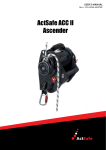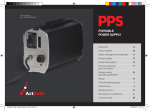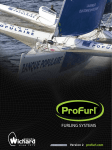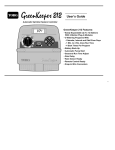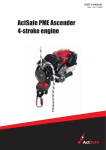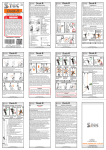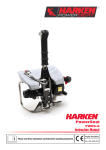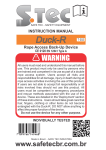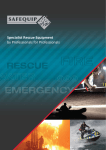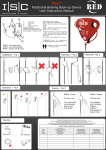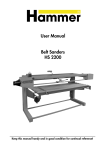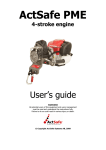Download ActSafe ACC II Ascender
Transcript
USER’S MANUAL Rev 1-2014 ENG MASTER ActSafe ACC II Ascender User’s Manual ACC II Ascender Rev 1-2014 2 Disclaimer This manual is not intended, in any way, to teach an individual how to use a power ascender. It is only to be used as a reference source in conjunction with a “controlled program of instruction” in the use of this power ascender system, conducted by a qualified ActSafe Instructor. An ActSafe Power Ascender is not a safety device. It is specifically designed as a tool to assist in the ascending and descending of personnel and tools or materials and is always to be used in conjunction with a fully independent working Backup system. Act Safe Systems AB makes no guarantee that the ActSafe Power Ascender will increase the user’s personal safety or free the user from possible serious injury or death or that the ActSafe Power Ascender operates as a lifesaving mechanism. Act Safe Systems AB, our partners and subsidiaries disclaim any liability or responsibility for damages, injuries or death resulting from the use or misuse of an ActSafe Power Ascender. The ActSafe Power Ascender should not be operated by persons who do not possess evidence of approved training in the use of the ActSafe Power Ascender, it is recommended that operators should have a rope access qualification. However, even with this requirement, Act Safe Systems AB has no control over the use of this equipment and the person using this equipment assumes all risk of damage, injuries or death resulting from such use. It is expressly understood and agreed by the buyer or any subsequent user of the ActSafe Power Ascender that Act Safe Systems AB and/ or the seller in no way be deemed or held liable or accountable for any liability or responsibility for damages, injuries or death resulting from the use of the ActSafe Power Ascender, and makes no warranty, either expressed or implied, statutory, by operation of law or otherwise, beyond that expressed herein. Act Safe Systems AB disclaims any liability in tort for damages or direct or consequential personal injuries or death resulting from a malfunction or from a defect in design, manufacturing, materials or workmanship, whether caused by negligence on the part of Act Safe Systems AB or otherwise. By using the ActSafe Power Ascender, or allowing it to be used by others, the buyer and/or user waives any liability on the part of Act Safe Systems AB for personal injuries, death or other damages arising from such use. Actsafe expressly disclaims liability for errors or omissions in this information and materials. This information may be subject to change without notification. WARNING Training and experience are required to lower the risk of serious bodily injury or death. NEVER use this equipment unless you have read the user’s manual and completed a “controlled program of instruction” in the use of this power ascender system. However, even with this requirement, Act Safe Systems AB has no control over the use of this equipment and the person using this equipment assumes all risk of damage, injuries or death resulting from such use. ACC II Ascender User’s Manual revision 1-2014 © Copyright 2013 ActSafe Systems AB www.actsafe.se | [email protected] 2 © Copyright ActSafe Systems AB Table of contents Disclaimer2 USAGE20 Checklist before and after use 20 INTRODUCTION4 Transportation21 Foreword4 Storage21 About ActSafe 4 Connect to rope 22 About this manual 4 Ascent & descent 23 Definitions 5 Emergency descent 24 Emergency stop 24 SAFETY6 Twisted ropes, rotation 25 Ascender safety 6 Remote control 26 General safety measures 6 Rope system safety 7 SERVICE & MAINTENANCE 28 Alternative setup of bac-up system 8 Clean the ascender 28 28 Rope recommendations 10 Clean the battery connecting pins Personal safety 11 Changing the primary connection sling 28 Training12 Remote control, changing the batteries 29 Spare parts SYSTEM DESCRIPTION 13 29 Material29 General14 Control panel 14 Battery & charging 15 Important information 15 General guidelines and warnings 15 Storage and transportation 16 Battery disposal 16 Connecting battery to ascender 17 Use in high temperatures 18 Use in low temperatures 18 Battery indicator 18 TROUBLE SHOOTING GUIDE 30 WARRANTY & GUARANTEE 33 TECHNICAL DATA 34 APPENDIX35 Charging19 User’s Manual ACC II Ascender Rev 1-2014 3 INTRODUCTION Introduction Foreword About this manual Thank you for choosing a product from Act Safe Systems. The information in this manual cannot replace training and exercise. The ascender must only be used by personnel who have undergone proper training. Misuse may result in serious injury or death. When used correctly this ascender will revolutionize the way you work at height. This hoisting equipment makes it much more convenient for you to reach your workplace in combination with lifting materials and tools. About ActSafe ActSafe introduced the worlds first commercially available Power Ascender back in 1997. Today we are the world leader within this growing segment. Our innovative Power Ascender are used all over the world in industrial, rescue and military operations. With almost two decades experience, and a worldwide distribution, we develop unique Power Ascender solutions in close collaboration with our customers. We are totally committed to our customers and do our outmost to deliver top quality products and service. Thank you for choosing an ActSafe Power Ascender. Visit our website for more information on ActSafe Power Ascenders. You will find important information and latest versions of manuals. www.actsafe.se 4 Description of the manual Safety messages of extra importance are presented with the words danger and caution. The meanings of the signal words are: CAUTION Not following these instructions may result in INJURY or damage to property. DANGER Not following these instructions may result in SERIOUS INJURY or DEATH. ReComMendation User recommendation is described like this. Further information about consequences and other details is presented like this. NOTE! The word “Note” will precede important information about the equipment used together with the ascender. © Copyright ActSafe Systems AB INTRODUCTION Definitions WORD DESCRIPTION Anchor Attachment point for rope or ascender. Ascending Moving up on the rope. Descending Moving down on the rope. Primary rope Primary rope used with ascender. Approved according to EN1891 A. Secondary rope Secondary rope that takes load if failure with primary rope. Approved according to EN1891 A. Backup Device that stops a fall and limits the load. Approved according to EN12841-A. Active / Live rope Rope that is loaded during work. Passive / Dead rope Unloaded rope during work. User / Operator Operator of the ascender, either by speed control handle or by remote control. There can be two or more at the same time. Competent person Personnel with adequate training and certification for the assignment. Factor 1 fall A fall of distance x m with x m of rope catching the fall. Fall factor is fallen distance divided by length of rope catching it. Descender Device for descending a rope. Approved according EN 12841 C. User’s Manual ACC II Ascender Rev 1-2014 5 SAFETY Safety Users of this product must have been certified or have undergone proper approved training either by ActSafe Systems or by ActSafe approved distributors. DANGER Read this chapter carefully and make sure you understand its contents. Ascender safety The ascender must not be used: •• For anything other than that for which it has been designed. •• In an explosive environment. •• If modified in any way by anyone other than ActSafe Systems. •• After a free fall from a height more than 1 meter against any hard surface. •• If subjected to a dynamic load as it is designed to work in static systems only. •• If subjected to mis-use in any way those parts or components may have been damaged. •• In combination with other than ActSafe original battery charger. •• In combination with damaged or modified battery charger. •• In combination with a not original Actsafe battery. Use only original spare parts / material recommended by ActSafe Systems. Other battery chargers may damage the battery and may cause development of toxic gases or in worst-case scenarios cause an explosion. If unclear of the condition of the ascender, it must be inspected and approved by ActSafe Systems or an ActSafe approved distributor before use. The ActSafe Ascender and its equipment must be checked before and after every use and must be subject to at least one inspection per year (national regulations may require more frequent inspections). General safety measures •• Plan and evaluate your work carefully, a rescue plan should be in place. If possible rig for rescue. •• Pre-use check. •• Due to the nature of workingwith ActSafe winches operatives are hanging for prolonged periods in a harness; we recommend the use of a work seat when hanging for prolonged periods. 6 ReComMendation • The area of risk under someone working at height is within a radius of 2/3 of the height and larger due to strong wind. Other persons must keep away from the area of risk. • Always secure tools and equipment. © Copyright ActSafe Systems AB SAFETY Rope system safety The rope system must consist of a primary rope (1) and a secondary back-up rope (2), both must be approved according to EN1891 A and have a diameter of 10-13mm. The two ropes must have separate anchor points that must hold at least 12 kN each. A competent person shall judge if the separate anchor points are sufficient. National regulations may require more. 1 3 2 The ACC ascends or descends on the primary rope. If any part of the load carrying system should break then the load is immediately transferred to the secondary rope which, together with the fall arrester (3) according to EN12841-A, provides a backup system. Do not descend on a twisted rope. It may result in a rope jam or in the worst-case scenario the rope being forced off the rope grab. Rope characteristics are an important issue when using the ascender. Ropes with characteristics not suitable for the ascender might, in the worst-case scenario, result in a jam between the rope grab and the knife, with a damaged rope as a consequence. DANGER Do not use the Ascender without a backup system. The lifting capacity of the ascender is higher than the Safe Working Load (SWL) of the most common backup devices. Therefore, when lifting a load it may be necessary with separate backup system(s) for the load. See the user’s manual of the fall arrest device to find out the SWL. The dead rope must be unloaded. Do not build cableways using the primary rope as shown in the picture. User’s Manual ACC II Ascender Rev 1-2014 7 SAFETY Alternative setup of backup system Next to the traditional setup of a separate work and backup system the ActSafe ACC ascender offers the possibility to make a combined setup of both systems while being connected to both work and fall arrest point on your harness. This setup gives advantages in both safety and handling while using the ascender. The backup device is connected, ideally via a twisted shackle, to the secondary connection point of the ascender the backup system stays then always in way of shoulder height of the operative. The advantages are: •• The winch is caught by the backup in case of a rope failure and will not hurt the operator. •• The high position of the backup device prevents slack in the backup system; this will prevent high shock loads on the system in case of a rope failure. •• The operative does not have to take care of his backup system it is kept in the right position by the ascender. 8 NOTE! Do not put the backup system directly into the secondary connection point. It will become very difficult, In case of a line failure, to put the secondary rope into to ascender safely for emergency descent/ ascent. •• Be aware that, in case of a rope failure, the operative is caught by the winch and not by his energy absorber. The impact force on both ascender and operator are very low because the backup is a very high position and next to that does the rope above the winch dampen the impact. We recommend that there is always a minimum of 1 meter of rope above the ascender when using this setup. Recommended equipment Shackle: Wichard stainless steel twisted captive pin shackle, 8 ømm, 3700 Kg breaking load. Product reference: 1424 Fixation rubber: Contact ActSafe dealer © Copyright ActSafe Systems AB SAFETY 1) Connect the twisted shackle with the rubber fixation, as shown, to the secondary connection point of the ascender. 2) Put first the backup carabiner trough the shackle before connecting this to the backup. 3) Connect the ascender to the low attachment point (EN 813) of the harness and connect the energy absorber of the backup to the fall arrest point (EN 361) and you are ready to go. User’s Manual ACC II Ascender Rev 1-2014 9 SAFETY Rope recommendations ActSafe ACC is designed for EN1891 A ropes. However, all EN1891 A ropes does not perform well with the ascender. ActSafe has tested a variety of ropes; please see our website for more information. Please read and understand the tips and directions regarding ropes below and you will get more out of your ropes as well as your ActSafe Ascender. As a rule of the thumb one can say that extremely soft ropes don’t get good grip in the rope grab. A very soft rope may result in poor lifting capacity since the rope starts to slip or in the worst-case scenario even a jam. DANGER Always make sure that the rope is in good condition. ReComMendation The user should carry out tests with the rope normally used prior to operations involving the ascender. Consult ActSafe for more information and assistance in the test of the rope. A new rope will get an increased service life if it is put to soak in cold water before the first use. Avoid getting sand or dirt onto/into the ropes since it will wear the rope grab and loop. Use a rope mat, rope bag or similar. Before using for the first time, new ropes must be soaked in cold water (20-30 C) for at least 24 hours or according to the rope manufacturers’ instructions, and allowed to dry thoroughly at room temperature before using with the power ascender. NOTE! Not all EN1891 A ropes perform in a similar way. They have slightly different characteristics (stiff, soft, thick/thin mantle etc). 10 © Copyright ActSafe Systems AB SAFETY Personal safety The user must wear a combination harness (1,2) approved according to EN813: 2008 (low attachment point for the primary rope, 3) as well as EN361 (high attachment point for the secondary rope or fall arrester, 4). Do not use the ascender if you are tired, ill or under the influence of alcohol, drugs or medication. 5 4 Before use make sure that you •• Check all components in the system. •• Use appropriate PPE (Personal Protective Equipment, for example helmet, gloves and protective eye wear, 5). •• Use appropriate clothes without loose hanging parts. •• If necessary bind long hair and beards to keep the shoulder region free. 3 When using make sure that you 1 2 •• Pay attention and use common sense. •• Do not hold the rope just above the winch; there is a risk of being pinched. •• Keep your hands and feet off rotating parts. •• Avoid pendulum movement when starting to ascend. User’s Manual ACC II Ascender Rev 1-2014 11 SAFETY Training Users of this product must have undergone proper approved training either by ActSafe Systems or by ActSafe approved distributors. The ActSafe ACC ascender makes it possible to access heights and depths in a very quick, safe and reliable way. The ascenders are very easy to implement within various work methods and is invaluable in places where access is difficult or impossible by other means. Because of the variety of use in different areas and circumstances training is essential. Working at height or in locations presenting difficult or confined access requires great skill and such standards can only be achieved as a result of extensive training and regular refresher courses. ActSafe offers winch specific user training for different competence levels as show below. Please consult with your local ActSafe distributor for further information. ACTSAFE BASIC+ WINCH TRAINING Duration: 1 Day Experience: Trainees should have as minimum requirement a good level of competence and training in work at height This training is designed for operatives who need good basic understanding for a specific on the job application of the winch. ACTSAFE ADVANCED WINCH ACCESS TRAINING ACTSAFE ADVANCED WINCH RESCUE TRAINING Duration: 2 day training Experience: Trainee should have a rope access level. This training is designed for rope access operatives to give them a thorough understanding how to use the winch in an rope access environment; general and job specific. Winch access! Duration: 2 day training Experience: Trainee should have a rope rescue background. This training is designed for rope rescue professionals to learn about rescue capabilities of the winch. This training provides general and job specific knowledge. Winch Rescue! ACTSAFE EXPERT TRAIN THE TRAINER TRAINING Duration: 2 day training Experience: Trainee should have attended a ActSafe Advanced Winch Access Training or have a solid Rope Access/Rescue background (Preferably IRATA L3 or similar). This training is intended for Rope Rescue / Access professionals to gain an in-depth knowledge of the ActSafe Winches so they can afterwards perform ActSafe Training. 12 © Copyright ActSafe Systems AB SYSTEM DESCRIPTION system description 3 2 1 4 13 12 11 10 6 8 9 5 7 NO PART NO PART 1 Rope grab system 8 Sling 2 Lifting handle 9 Attachment karabiner 3 Control Panel 10 Chassis 4 Pocket for Emergency Descender handle 11 Secondary Connection point 5 Speed control handle 12 Battery Connector (hidden) 6 Emergency stop 13 Battery pouch 7 Primary connection (8+9) User’s Manual ACC II Ascender Rev 1-2014 13 SYSTEM DESCRIPTION 1 4 2 3 NO PART 1 Rope guide 2 Knife 3 Rope cover 4 Rope grab General Control panel This ascender has been designed for lifting/ lowering a person or load in a static rope system (including secondary rope), with ropes of 10-13mm approved by EN1891. The dead rope shall be unloaded. All buttons are equipped with LEDs that indicate the travel mode that is active. 1 2 3 4 The karabiner in the primary connection can be replaced by any other karabiner approved by EN362. The sling in the chassis cannot be replaced, by anything other than an original spare part from ActSafe Systems. 14 NO PART 1 Battery indicator 2 Power button 3 Ascend button 4 Descend button © Copyright ActSafe Systems AB SYSTEM DESCRIPTION Battery & charging Important battery safety and handling information! ActSafe Power Ascender batteries are extremely powerful but at the same time compact and lightweight. The batteries use high performance lithium-based battery technology that delivers very high power and energy density. Charged and used correctly your ActSafe Power Ascender battery will give you a high level of performance throughout its service life. However, lithium-based battery technology is still in development. To minimize the associated risks our batteries have a custom designed Battery Management System (BMS). This BMS reduces risks considerably, but cannot totally eliminate all risks. The BMS itself could break down or a battery cell might have an internal weakness not detectable during the manufacturing process. It is not possible to design a totally failsafe BMS. Please read and understand these safety instructions and warnings before using or charging your ActSafe Power Ascender battery. By purchasing an ActSafe battery, the buyer assumes all responsibility for all risks associated with lithium-based battery technology. Product warranty is limited to original defects in material and workmanship. Warranty does not cover collateral damage. Failure to read and follow the instructions below may result in fire, personal injury and damage to property if the battery is charged / used improperly. User’s Manual ACC II Ascender Rev 1-2014 General guidelines and warnings •• Disconnect the battery from the ascender when not in use. •• Always charge the battery as soon as possible after use. •• Disconnect the battery from the charger after charging. •• The battery may explode resulting in fire if misused or if the battery is defective. All users of the ActSafe Power Ascenders and associated batteries must be professionals who can handle an emergency situation. •• A severe failure during charging of the battery may result in fire or explosion. Unattended charging must be conducted in a safe and isolated area away from combustible or other flammable materials and where any potential damage is minimized. •• An old or spent battery, or a battery showing poor performance, must be taken out of service and replaced with a new one. A Power Ascender is a demanding battery application. This contributes to a relatively short service life for the battery. - Replace the battery in accordance with the expiry date label1. - Replace the battery when less than 80 % of the initial capacity remains. •• Immediately remove the battery from service: - If there is visible damage to the housing, cables or the connector, including the battery connector on the power ascender. - If the battery has been dropped. The battery may have received internal damage that cannot be detected from the exterior. 15 SYSTEM DESCRIPTION •• Allow the battery to cool down to ambient temperature before charging. •• Only use the original ActSafe battery charger. •• Do not short circuit the battery. This can cause fire. If a short circuit occurs and contact is made with metal (for example with rings on your hand), severe injuries may occur due to the conductibility of electric current. •• Do not disassemble or modify the battery. The battery contains safety and protection devices, which, if damaged, may cause the battery to generate heat, explode or ignite. •• Immediately discontinue use of the battery if, while using, charging or storing the battery, the battery emits an unusual smell, feels hot, changes shape, or appears abnormal in any other way. Since a delayed chemical reaction can occur, it is best to observe the battery for at least 15 minutes as a safety precaution. Observation should occur in a safe area outside of any building or vehicle and away from any combustible material. Storage and transportation •• All lithium-ion batteries degenerate over time, they age, even if they are properly stored. •• Store the battery with 100 % charge. •• Storing an empty battery or a battery with low charge level will drain the battery and damage it irreversibly. •• Recharge the battery every third month if stored for an extended period of time. •• Store the battery at room temperature 5 to 25 degrees C (40 to 80 degrees F). Storing at higher temperatures will result in a loss of performance and a shortened life expectancy. •• Storing the battery at a higher temperature can cause irreversible damage. Storing the battery at temperatures higher than 60 degrees C (140 degrees F) for extended periods of time may cause damage to the battery and possible fire. •• The battery is a fully regulated as Dangerous Goods (Class 9 UN3480 Lithium Ion Batteries) and must be handled and shipped accordingly. •• Do not expose the battery to water or salt water, or allow the battery to get wet. •• A defective battery must not be shipped. •• Do not overcharge the battery. Overcharging may occur during descending with a fully charged battery. Descending should be done with a partially charged battery. •• Do not incinerate or dispose the battery. Return end-of-life battery to your nearest recycling center as per the appropriate regulations. Battery Disposal 1) Batteries produced after June 2013 are marked with an expiry date label. Batteries purchased before this date, without an expiry date label, should be taken out of service after 24 months at the latest from the date of purchase from the ActSafe distributor. 16 © Copyright ActSafe Systems AB SYSTEM DESCRIPTION Connecting the battery to the ascender 1. Align the slit of the battery connector with the tap of the male connector placed inside the bag of the ascender. 2. Rotate the ring of the connector all the way to the stop position in order to lock the connector in place. There might be a small spark when connecting the battery, this is normal. ReComMendation ActSafe recommends having at least one extra battery when working in order to avoid undesired breaks as a result of a flat battery. ReComMendation When used in cold environments maintain the battery temperature by keeping the battery in the transportation box as long as possible. This will prolong the time before performance is limited. When using the ascender with a cold battery, be aware that the initial lift speed capacity will be limited. It is only possible to ascend at lower speeds before the battery warms up and normal performance can be expected. 1 User’s Manual ACC II Ascender Rev 1-2014 1 2 17 SYSTEM DESCRIPTION Use in high temperatures Battery indicator The capacity is less affected by high battery temperature. The lifted height will be slightly decreased. The ascender is well designed to do its work in the full temperature range. The risk of over heating is very small. The battery indicator has 4 LEDs each representing 25% charge. Use in low temperatures The capacity of the battery depends on the battery temperature. Extreme temperatures will affect the capacity, most noticeably in cold temperatures. When the battery is cold it can behave as if the charge level is low. This may cause the battery indicator to show the wrong level. The indicator will return to normal after next recharge. 18 When connecting a fully charged battery to the ACC all LEDs of the indicator will be activated, i.e. indicating a full battery. The battery indicator only functions correctly if a fully charged battery is connected. If a battery with less than full charge is connected the indicator will show the last known value, i.e. the indicator will show an incorrect value. LEDs BATTERY CAPACITY 1 red 3 green 75-100% 1 red 2 green 50-75% 1 red 1 green 25-50% 1 red 0-25% © Copyright ActSafe Systems AB SYSTEM DESCRIPTION Charging Ready to use CHARGER LED COLOR Time lapse: Charged: 3 1 FAST CHARGING 2 0 SLOW CHARGING 5 FLOAT 4 1:15 hrs 80% The battery can be charged whether its only used a little or if almost empty, no so called ”memory effect” will occur. The charger is not capable of measuring the charging level; hence it cannot determine when the battery is fully charged. For this reason the charger is timer controlled. The charging process consists of the cycle described below: 1. Connect the charger to main supply. 2. Connect the battery to the charger. 3. Constant current charging (fast charging). During this cycle the LED on the charger is red. This phase takes approximately 1 hour and 15 minutes. After this cycle is finished the battery is charged to 80%. 4. Constant voltage charging (slow charging). During this phase the led on the charger is yellow. After approximately 3 hours and 30 minutes after the charging started the battery has 100% charge, however the charging cycle continues as the cells in the battery sometimes need to be balanced. BALANCING 3:30 hrs 100% CHARGING 6 7 5:15 hrs 100% 5. After 5 hours and 15 minutes the charging cycle is complete and the led on the charger is green. Float charging mode will start automatically. 6. Disconnect the battery from the charger as it will slowly be drained if it remains connected to the charger. 7. Disconnect the charger from main supply. ReComMendation The total charging cycle is all together around 5 hrs. The battery is however fully charged already after 3,5 hrs. The battery may therefore be disconnected after 3,5 hrs, there is no need to wait until the LED shows GREEN. Use the transportation box to extend the service life of the ascender. CAUTION Failure to disconnect the charger from the battery when the charger is disconnected from the mains supply will slowly drain the battery to a level where charging is no more possible. DANGER If the main supply is interrrupted several times during the second cycle (and the 4 hrs timer reset) there is a risk of over charging, i.e. a risk of damaging the battery. User’s Manual ACC II Ascender Rev 1-2014 19 USAGE usage Checklist before and after use The user must make sure that the ascender is in full working order and the pre-use check have been made before each use of the ascender. If in doubt do not use the ascender and consult ActSafe or an approved distributor. Inspect the rope grab system in particular; Check the ascender and its components for loose parts, excessive wear and damages. Damage includes cracks, marks and/or abnormal wear indicating the product has been subject to excessive force or impact energy. •• The knife. •• The rope grab, for example the ridges, should be intact. •• The rope cover. •• The rope guide. Further inspect •• The primary connection; the sling and the karabiner. •• The chassis, especially the area for the primary connection. •• That the ascender functions and controls are fully functional. •• The battery charge level is sufficient for the assignment. •• Annual inspection performed according to ActSafe’s recommendations as well as national regulations. •• All other parts. DANGER If the rope guide is less than 7mm thick, it shall be replaced. 20 If in doubt about the condition of the ascender consult either ActSafe Systems or an approved distributor. © Copyright ActSafe Systems AB USAGE Transportation Storage For short transports, carry the ascender by the lifting handle. Always clean and dry the ascender and the transportation box before putting it away for storage. During normal transport the transportation box is optimal as it protects the ascender from damage. Always make sure the Ascender is secured before being transported in a vehicle. The batteries contains more than 100 Wh and therefore considered dangerous goods. Make sure they are transported in accordance with local rules and regulations. Store the ascender and the remote in a cool and dry place. It can be stored in the transportation box, make sure it is dry. CAUTION Always store the battery fully charged. Never store the battery connected to the ascender. Never store the battery connected to the charger. If stored for long periods, charge the battery once every three months. User’s Manual ACC II Ascender Rev 1-2014 21 USAGE Connect to rope 1. Place the ascender on the ground 2. Open the rope cover. 3. Form a loop on the rope and push it through the rope guide just above the rope grab. 4. Put the rope around the rope grab 5. Close the rope cover. 6. Connect the primary connection karabiner to the EN 813:2008 connection point of the full body harness and check the karabiner is locked. Check that the live rope exits to the left and that the rope cover is fully closed. Attaching the rope incorrectly can result in serious injury or death. Always use the ascender with a secondary rope system. ReComMendation Drive the ascender to waist level to simplify connection to harness. 22 DANGER Make sure that the rope is attached correctly before use. CAUTION Always push the emergency stop before loading the rope to avoid accidental activation by the remote control while loading the rope. © Copyright ActSafe Systems AB USAGE Ascent & descent 1. Switch the ascender on. DANGER 2. Choose travel direction up/down. Should the rope cover open at any point during ascent or descent, stop immediately and close it again before continuing. 3. Turn the speed control towards you to increase the speed. 4. Feed away the dead rope gently during the first few meters of ascent. After approx 5 meters the weight of the rope will be sufficient to “clean” itself from the ascender. CAUTION Do not hold the rope just above the winch, there is a risk of being pinched. 5. Stop the motion by turning the handle away from you or letting it go. ReComMendation Always make sure that the rope feeds smoothly. During ascent make sure the outgoing rope is not blocked in any way. During descent make sure no twists pass the rope guide. 1 Never start descending with a fully charged battery as it can cause overcharging and damage the battery. Stand straight beneath the anchor point in order to avoid a pendulum movement when starting off the ground. Adjust the speed according to the circumstances, be aware and use common sense. 2 If balance is needed, hold on to the primary connection sling or karabiner. If you know that your work will start “top down” then start with a partial charge depending on distance. As a rule of thumb each LED on the ACC equals 50 meters with 120 kg load. It is always safe to descend the same distance as you have ascended on the same battery. 4 User’s Manual ACC II Ascender Rev 1-2014 3 23 USAGE Emergency descent Whenever the ascender is not running the mechanical brake is activated. This brake can be controlled manually to allow an emergency descent. The function should be treated as a normal descending device. Only use in case of emergency, normal descending shall be used whenever possible. The battery is charged during normal descent as well so you don’t save any battery capacity by using emergency descent. DANGER Emergency descending results in uncontrolled charging of the battery which may damage the battery. The risk is increased with a fully charged battery. Descend slowly to reduce the risk of battery damage. CAUTION Do not use the emergency descender over very long distances. 1. Place a hand on the dead rope. 2. Descend by gently pressing the handle to the side. Stop the descent by letting go of the descend handle. ReComMendation In most cases the emergency descent is not needed as the ascender can be restarted to allow normal descent with the motor. Adjust the speed according to the circumstances, be aware and use common sense. *) *) Descent slowly and safely. 2 1 Emergency stop 1. Press the emergency stop to immediately turn the ascender off. 2. Reset the emergency stop by twisting it clockwise. CAUTION The remote control doesn't work when the emergency stop is activated. 24 © Copyright ActSafe Systems AB USAGE Twisted ropes, rotation Badly twisted ropes, e.g. as a result of the operator rotating/spinning during ascent/ descent may be dangerous and should be avoided. A badly twisted rope may cause a rope jam that makes the ascender non operable. In the worst-case scenario the rope can be forced off the rope grab, with serious injury or death as a result (if a back-up rope system is not used). In the unlikely event that the rope is spooled out between the rope guide and the rope grab, either when ascending or descending then stop immediately operating the winch. Connect your descender or chest ascender to the secondary rope and tension this rope and change the backup device to the primary rope above the winch. Unload the rope that is connected to the winch by descending further with the winch, open up the rope cover and fit the rope correctly in to the rope grab. Ascend a little with the winch and check if the rope is correctly guided through the rope guide, if this is the case then change the backup device back to the secondary rope and then disconnect the descender from the rope. Do not try to correct the rope feed while still suspended in the ascender. DANGER When descending, make sure the rope goes cleanly in to the rope grab, i.e. that there are no curls or similar on the rope. This is extra important when working with the ascender fixed next to the rope bag or pile of rope so that unloaded rope is constantly fed to the ascender. Guide the rope with your hand to make sure no twists pass to the rope guide. User’s Manual ACC II Ascender Rev 1-2014 25 USAGE Remote control The remote is primary a rescue tool, allowing another person to move the operator up or down in case of an emergency. However, the possibilities when using the remote in other applications are numerous. Such application shall be trained in a safe environment, and as always a back-up system shall be used. The remote control allows the ascender to be operated from a distance. The remote control will override the control buttons on the ascender, i.e. when the remote is switched on it will not be possible to operate the ascender by its own controls. If the remote is not used it will automatically switch off after 10 seconds. The ascender will need to be switched on for the remote to function. When shutdown the ascender will be in standby mode for 4 hours allowing the remote to start it. ReComMendation Be careful operating the remote if you don’t have visual contact with the ascender. Always use the remote in combination with a stop knot at each end of the rope. The remote shall have visual contact with the ascender to ensure maximal range. When the ascender is powered off it can be reactivated from the remote control for 4 hours. The remote control is not watertight. The protection class is IP65 (i.e. no ingress of dust and water projected by a nozzle against enclosure from any direction shall have harmful effect). The remote allows ascending and descending at 2 different speed alternatives; slow and fast. (25% and 75% of maximum speed respectively) 26 © Copyright ActSafe Systems AB USAGE 5 6 1 3 4 2 Several remote controls can be used with one ascender, of which only one can be active at each time. Contact ActSafe or your distributor for more information. When used with several remote controls the first one to contact the ascender will be active. To change remote, wait until the first remote automatically turns off. The power for the ascender must be turned on (if not recently used). 1. Press any button on the remote to activate it. (The green LED will flash 3 times before going steady if connection with ascender is successful) 2. Press the down/up button once for slow speed, twice for fast speed. 3. Press the “Activate” button to ascend/descend at selected speed and direction. NO PART 1 Ascend speed button 2 Activate button 3 Descend speed button 4 Slow speed LED (red) 5 Fast speed LED (red) 6 Power LED (green)*) *) When power LED is flashing red, the battery in the remote is running low. Change the batteries in the remote. The remote control holder is equipped with a full strength sling allowing it to be used to connect person or load. This sling is a part of the ascender system and cannot be used as a separate sling in other applications. ReComMendation When ascending remote controlled with the ascender in the anchor, attach the remote holder to the harness and connect to the upper part of the remote holder sling to get an ergonomic operating position. The remote control hand unit only works with the Power Ascender it has been delivered with. If several Power Ascenders with remote control, hand units should be marked so it is clear wich Power Ascender it belongs to. CAUTION The remote shall have visual contact with the ascender to ensure maximal range and safety. If you have several ascenders with remote controls, then make sure they are properly marked (e.g. color coding or numbering) to avoid potential dangers by using the wrong remote. User’s Manual ACC II Ascender Rev 1-2014 27 SERVICE & MAINTENANCE service & maintenance Use only original spare parts / material recommended by ActSafe Systems. Clean the unit regularly. Check the charging pins and karabiners for oxidation. Clean and lubricate if needed. Clean the ascender NOTE! Do not use running water or a highpressure washer! •• Wipe the ascender with a wet cloth and let it dry. •• Clean the karabiner thoroughly, lubricate with thin oil. Clean the battery connector pins Spray the pins with an electronic connector cleaner/lubricator when needed. ReComMendation Go through “Checklist before and after usage” at every maintenance to increase the safety for the user (/users) of the ascender. Changing the primary connection sling If unsure of any of these steps, contact ActSafe Systems or local distributor. 1. Use pliers to force the captive bar out. ReComMendation We recommend that you change the karbiner and the sling at the same time. 2. Remove the karabiner and the sling. 3. Push the sling through the chassis holes. Use thin, long pliers to do this. 4. Connect the karabiner and lock it with a captive bar. 28 © Copyright ActSafe Systems AB SERVICE & MAINTENANCE Remote control, changing the battery 1. Remove the battery cap (2 screws). 2. Replace the batteries (AA). 3. Reattach the battery cap (2 screws). Spare parts The most common parts are listed here, contact ActSafe Systems or your local distributor if you don’t find your part here. Rope grab 49-150-201 Material Cover50-160-103 Knife 50-150-105 Rope guide49-160-309 Sling50-160-135 Thin Oil CRC 5-56 Loctite 243 Karabiner50-105-052 User’s Manual ACC II Ascender Rev 1-2014 29 TROUBLE SHOOTING GUIDE trouble shooting guide If this guide does not solve your problems, contact ActSafe Systems or by ActSafe approved distributor. No power when main switch is pressed PROBABLE CAUSE REMEDY The emergency stop is activated. Disengage the emergency stop. The battery is flat. Recharge the battery. No response to speed handle PROBABLE CAUSE REMEDY The ascender is not switched on. Switch the power on. The remote control is switched on. Restart the ascender or wait for the remote to turn off. The battery is flat. Recharge the battery. The ascender stops on ascent/descent 30 PROBABLE CAUSE REMEDY The ascender is overloaded. Ensure the load is not exceeding lifting capacity and restart by return the handle to zero. The rope is jammed. Do not try to clear the jam under load as it can be dangerous! See “twisted ropes and rotation” page 25 for advice. The battery is flat. Recharge the battery. © Copyright ActSafe Systems AB TROUBLE SHOOTING GUIDE The ascender do not start or switches off when newly recharged PROBABLE CAUSE REMEDY The battery is to cold. Warm the battery. See technical data for temperature range. The charger fuse is burned. Check the fuse and replace if needed. See instruction 2. The charger is broken/damaged. Repair/replace the charger, contact ActSafe or an approved distributor. See instruction 2. The battery is flat. The ascender is in need of repair and service, contact ActSafe or an approved distributor. See instruction 1. The emergency stop is activated Deactivate the emergency button. 1) Measure the voltage (on pins I and H as shown in the picture) of the battery with a common voltmeter. It shall be 37,2 V when the battery is fully charged. 2) Measure the voltage (on pins A and I as shown in the picture) of the charger at the battery connector with a common voltmeter, when the charger is connected to the wall socket. It shall be 39,6 V if the charger is ok. CAUTION Be careful not to short curcuit any pins while measuring the voltage on the battery and the charger. User’s Manual ACC II Ascender Rev 1-2014 31 TROUBLE SHOOTING GUIDE Ascender operates at very low speed PROBABLE CAUSE REMEDY The battery is to cold. Warm the battery. See technical data for temperature range. The ascender or the batterie is to warm. Let the ascender or the batterie cool down. The ascender is over loaded. Lighten the load. The grab on the rope is poor, the rope slips PROBABLE CAUSE REMEDY Rope connected incorrectly. Reconnect the rope. The rope is not suitable for the ascender. Change the rope. The rope grab is worn. The ascender is in need of repair and service, contact ActSafe or an approved distributor. The remote control cannot operate the winch when LED is green PROBABLE CAUSE REMEDY The distance to the winch is too far. Move closer to the ascender or replace the battery of the remote. There are objects disturbing the signal. Move closer to the ascender to get a stronger signal. The ascender is not powered up. Turn the ascender on. The ascender is broken/damaged. Check the trouble shoot guide regarding the ascender. Wrong remote control is used. Change to correct remote control. The LED on the remote flashes red PROBABLE CAUSE REMEDY The battery is running low. Replace the batteries of the remote control. The remote is corrupt. Consult ActSafe or an approved distributor. The ascender is very hot and there is no response to the speed handle 32 PROBABLE CAUSE REMEDY The ascender is over heated. Wait for the ascender to cool down. © Copyright ActSafe Systems AB WARRANTY Power Ascenders Warranty Terms ActSafe Systems AB (“ActSafe”) guarantees the Power Ascender (“product”) purchased to be free from defects resulting from the use of faulty parts or poor workmanship during its manufacture subject to terms of the limited warranty ("warranty") given below. •• The claim will have to be made within the warranty period, i.e. one year from delivery unless otherwise agreed. •• ActSafe will repair or, if necessary in ActSafe’s opinion, replace any defective parts and correct any problems resulting from poor workmanship free of charge. •• ActSafe reserves the right to use reconditioned parts with performance parameters equal to those of new parts in connection with any services performed under Act Safe’s limited warranty. Warranty Limitations •• The warranty is not transferable from one user/customer to another. •• The warranty does not extend to parts or products requiring replacement due to normal wear and tear, corrosion, rust, stain, etc., •• Any service, repair or replacement not within the scope of ActSafe’s coverage shall be subject to the rates and terms of the ActSafe approved service center performing such service. Claim under ActSafe’s warranty Except for the warranties set fort herein, •• Claim under ActSafe’s warranty may be made only by those customers who have registered their purchase with ActSafe within 15 days of receiving the product. ActSafe disclaims all other warranties, express or implied or statutory, including, but not limited to the implied warranties of merchantability or fitness for a particular purpose. Any implied warranties that may be imposed by applicable law are limited to the duration of this limited warranty. In no event shall ActSafe be liable for any incidental, special or consequential damages, consequential human injury or loss, including, but not limited to loss of business, profits or use whether in an action in contract or tort or based on a warranty arising out of or in connection with the use or performance of the product or any ActSafe supplied accessories which accompanies the product even if ActSafe has been advised of the possibility of such damages. •• In case of products that are not registered, the original sales invoice must accompany the claim. The warranty does not apply if: •• A damage or defect has occurred due to physical breakage, electrical faults external to the product, water penetration of the product, abuse or events of force majeure. •• The product is modified, maintained or repaired by a party not authorized by ActSafe. •• The product is maintained and operated in ways other than as recommended by ActSafe. •• The serial number stickers have been removed or tampered with. •• A non ActSafe certified product is added on to the product. User’s Manual ACC II Ascender Rev 1-2014 The customer agrees that repair or replacement, as applicable, under the warranty services described herein are the sole and exclusive remedies with respect to any breach of the ActSafe’s limited warranty set forth herein. If any provisions of this limited warranty are held to be unenforceable or illegal, the continuation of the other provisions will not be affected. This warranty will also not affect the customer's mandatory rights under applicable Swedish laws. 33 TECHNICAL DATA technical data NOTE The performance is tested with an unused 11 mm, unwatered rope at room temperature. 34 Speed, load, characteristics of ascent/ descent will affect the battery capacity; in many cases the capacity may well exceed the 200 meters on one charge. PERFORMANCE/PART VALUE COMMENT Rope Static / Semi Static rope 10-13 mm EN1891 11 mm preferred. “Rope must be watered before first use”. Max working load 250 kg Safe Working Load (SWL) 200 kg Overload limit 260-280 kg (approx) Ascent speed 0-22 m/min Continuous adjustment. Descent speed 0-25 m/min Continuous adjustment. Emergency descent speed 0-25 m/min Continuous adjustment. Battery capacity 200 m with 120 kg load At 20°C, ascending Charging time 3,5 h Temperature range -20 °C to + 50°C Over heating protection Yes Weight 15 kg Dimentions 38 x 25 x 30 cm Remote control range Up to 100 meters Excluding battery. The remote shall have visual contact with the ascender to ensure maximal range. © Copyright ActSafe Systems AB APPENDIX appendix Declaration of conformity and EC Type test Certificate. Declaration of EC conformity In accordance with Machinery Directive 2006/42/EC, appendix II A ActSafe Systems AB Sagbäcksvägen 13 SE43731 Lindome, Sweden We hereby declare that the power ascender type ActSafe ACC (Mark II) for the lifting and lowering of loads and persons meets the fundamental requirements of the below stated EC directives: EC Machinery Directive 2006/42//EC Low Voltage Directive 2006/95/EC Including the associated amendments. Applied harmonized standards, in particular DIN EN 14492-1 Cranes - Power driven winches and hoists Part 1: Power driven winches (02.2007) Applied national directives, in particular BGR 159 Hochziehbare Personenaufnahmemittel (hoistable access equipment) The design was inspected by Fachausschuss Maschinenbau, Hebezeuge, Hütten- und Walzwerksanlagen Prüf- und Zertifizierungsstelle im BG-PRÜFZERT BG-Bescheinigung Nr. 08 006 (Committee of experts - mechanical engineering, lifting gear, smelting works and rolling mills Testing and certification body in BG-PRÜFZERT BG-certification No. 08 006) Lindome 2009-12-29 ActSafe Systems AB Magnus Glans Managing Director ActSafe Systems AB Sagbäcksvägen 13 SE43731 Lindome SWEDEN User’s Manual ACC II Ascender Rev 1-2014 Phone: +46 (0) 31 655 660 Fax: +46 (0) 31 655 669 [email protected] www.actsafe.se VAT:SE556035133901 35 © Copyright ActSafe Systems AB Distributor: 1 ActSafe Systems AB Sagbäcksvägen 13 | SE-437 31 Lindome | Sweden Phone +46 31 65 56 60 | Fax +46 31 65 56 69 info@ actsafe.se | www.actsafe.se www.actsafe.se © Copyright ActSafe Systems AB




































